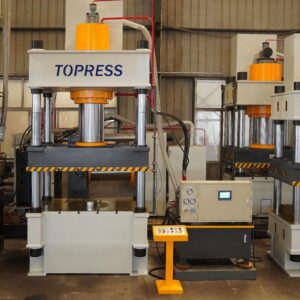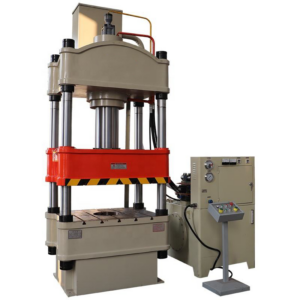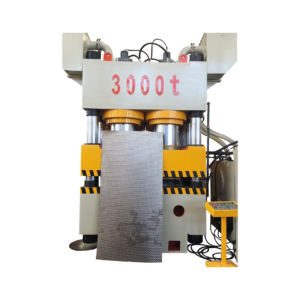Precision Embossing: Technology and Key Features
The Hydraulic Stainless Steel Door Panel Embossing Machine uses advanced hydraulic technology for high precision and efficiency. It applies Pascal’s Law to transmit and amplify pressure through key components such as the high-pressure plunger pump, hydraulic cylinder, and integrated valve block. The electric motor drives the oil pump, pressurizing hydraulic oil to generate thrust. This thrust is applied to the upper die via a movable crossbeam, deforming the stainless steel sheet and replicating the die pattern.
A PLC system fully manages the process, adjusting injection speed, operating pressure, dwell time, and return speed. These adjustments ensure consistent embossing depth and high-definition patterns. The machine handles pressures from 25 MPa to 31.5 MPa, with opening heights ranging from 1000 mm to 1800 mm and slide strokes from 300 mm to 600 mm. The main motor power varies from 30 kW to 90 kW. The servo-driven hydraulic system reduces energy consumption by up to 60%, improving overall efficiency.

Available Models for Every Need
Several models cater to different production needs. The standard gantry-type embossing machines offer versatility for flatbed embossing applications. For increased efficiency, models with dual movable worktables allow simultaneous die installation and embossing, reducing downtime. Servo-powered energy-efficient models reduce energy consumption by 30% to 60% and minimize noise. For demanding applications, heavy-duty models offer higher system pressures and larger opening heights, enabling ultra-deep embossing.
Industry Applications and Future Trends
Embossed stainless steel sheets are widely used in luxury interiors, elevator decorations, commercial partitions, and building facades. The embossing enhances visual appeal and strengthens the material with a rib effect, increasing rigidity.
Looking ahead, hydraulic embossing machines will integrate into intelligent production lines. They will work alongside automated loading, unloading, pre-treatment, and stacking systems, enabling efficient, unmanned production. This integration will improve efficiency, reduce labor costs, and ensure consistent, high-quality results.



